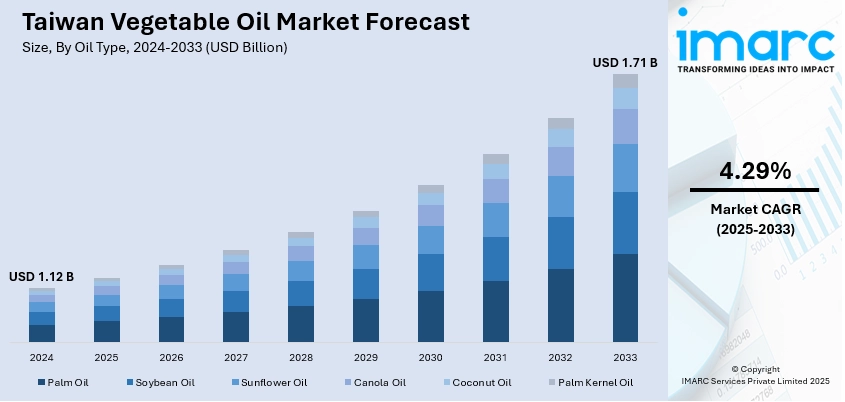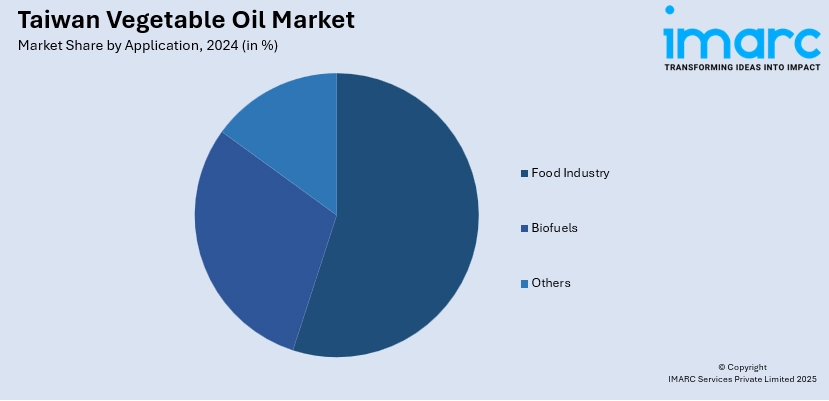
Taiwan Vegetable Oil Market Size, Share, Trends and Forecast by Oil Type, Application, and Region, 2025-2033
Taiwan Vegetable Oil Market Overview:
The Taiwan vegetable oil market size reached USD 1.12 Billion in 2024. Looking forward, the market is projected to reach USD 1.71 Billion by 2033, exhibiting a growth rate (CAGR) of 4.29% during 2025-2033. The market is driven by high domestic consumption across households, restaurants, and night market vendors due to the central role of oil in Taiwanese cuisine. Regulatory reforms have strengthened food safety and consumer confidence, encouraging transparent and clean-label products. Industrial demand from food processors and personal care manufacturers is further augmenting the Taiwan vegetable oil market share.
|
Report Attribute
|
Key Statistics
|
|---|---|
|
Base Year
|
2024
|
|
Forecast Years
|
2025-2033
|
|
Historical Years
|
2019-2024
|
| Market Size in 2024 | USD 1.12 Billion |
| Market Forecast in 2033 | USD 1.71 Billion |
| Market Growth Rate 2025-2033 | 4.29% |
Taiwan Vegetable Oil Market Trends:
Widespread Culinary Usage in Home and Restaurant Cooking
Vegetable oil is central to Taiwanese cooking, which relies on stir-frying, deep-frying, and braising techniques common in traditional dishes such as lu rou fan, fried rice, and night market fare. Soybean, canola, and sunflower oils are the primary oils used in home kitchens due to their affordability, neutral flavor, and nutritional appeal. Taiwan imports approximately 2.6 million metric tons of soybeans annually, primarily from the United States and Brazil. The majority of these imports are utilized by the edible oils industry for soybean oil extraction, as well as in the livestock sector for feed. Taiwan's high restaurant density and vibrant street food culture further amplify oil consumption, with small eateries, bubble tea shops, and night stalls relying on bulk quantities for daily operations. Both household and commercial consumers demand consistency in quality, flavor stability, and heat tolerance. Supermarkets and hypermarkets across urban centers provide refined oils in hygienic, traceable packaging, often accompanied by functional claims such as “non-GMO,” “cholesterol-free,” or “low saturated fat.” Local producers and importers supply both domestic and global brands to cater to diverse consumer preferences. Regulatory agencies such as the Taiwan Food and Drug Administration (TFDA) enforce strict quality and labeling standards, further enhancing consumer trust. This dual engine of household usage and vibrant out-of-home consumption reinforces the oil’s critical role in daily culinary practice, anchoring Taiwan vegetable oil market growth through steady, multi-channel demand.

To get more information on this market, Request Sample
Expanding Applications in Packaged Food and Personal Care Sectors
Vegetable oil plays a vital role in Taiwan’s fast-growing packaged food and cosmetics industries. Taiwan's edible oils market is projected to generate revenue of USD 491.86 Million in 2025, with a compound annual growth rate (CAGR) of 3.59% from 2025 to 2030. By 2030, market volume is expected to reach 116.39 million kilograms, with a growth rate of 3.2% in 2026. In comparison. Local food manufacturers rely on oils for snacks, instant noodles, frozen dim sum, and baked goods, all of which are in high demand domestically and for export to East Asia and Southeast Asia. These companies require stable supply and strict consistency in oil characteristics such as smoke point, odor neutrality, and shelf life. Palm, soybean, and rice bran oils are commonly used as food additives, emulsifiers, and frying agents. Outside of food, vegetable oil derivatives such as tocopherols and fatty acid esters are widely used in Taiwan’s personal care, skincare, and beauty products—especially those in the K-beauty and J-beauty markets. Local cosmetic brands and OEM manufacturers incorporate sunflower and coconut oil into cleansers, moisturizers, and shampoos, aligning with consumer preferences for botanical and sustainable formulations. The increasing convergence of food-grade and cosmetic-grade oil applications creates new opportunities for product diversification and value addition. As Taiwan positions itself as a hub for high-quality, exportable consumer goods, the cross-industry utility of vegetable oil reinforces its strategic economic relevance.
Taiwan Vegetable Oil Market Segmentation:
IMARC Group provides an analysis of the key trends in each segment of the market, along with forecasts at the country and regional levels for 2025-2033. Our report has categorized the market based on oil type and application.
Oil Type Insights:
- Palm Oil
- Soybean Oil
- Sunflower Oil
- Canola Oil
- Coconut Oil
- Palm Kernel Oil
The report has provided a detailed breakup and analysis of the market based on the oil type. This includes palm oil, soybean oil, sunflower oil, canola oil, coconut oil, and palm kernel oil.
Application Insights:

- Food Industry
- Biofuels
- Others
The report has provided a detailed breakup and analysis of the market based on the application. This includes food industry, biofuels, and others.
Regional Insights:
- Northern Taiwan
- Central Taiwan
- Southern Taiwan
- Eastern Taiwan
The report has also provided a comprehensive analysis of all major regional markets. This includes Northern Taiwan, Central Taiwan, Southern Taiwan, and Eastern Taiwan.
Competitive Landscape:
The market research report has also provided a comprehensive analysis of the competitive landscape. Competitive analysis such as market structure, key player positioning, top winning strategies, competitive dashboard, and company evaluation quadrant has been covered in the report. Also, detailed profiles of all major companies have been provided.
Taiwan Vegetable Oil Market Report Coverage:
| Report Features | Details |
|---|---|
| Base Year of the Analysis | 2024 |
| Historical Period | 2019-2024 |
| Forecast Period | 2025-2033 |
| Units | Billion USD |
| Scope of the Report |
Exploration of Historical Trends and Market Outlook, Industry Catalysts and Challenges, Segment-Wise Historical and Future Market Assessment:
|
| Oil Types Covered | Palm Oil, Soybean Oil, Sunflower Oil, Canola Oil, Coconut Oil, Palm Kernel Oil |
| Applications Covered | Food Industry, Biofuels, Others |
| Regions Covered | Northern Taiwan, Central Taiwan, Southern Taiwan, Eastern Taiwan |
| Customization Scope | 10% Free Customization |
| Post-Sale Analyst Support | 10-12 Weeks |
| Delivery Format | PDF and Excel through Email (We can also provide the editable version of the report in PPT/Word format on special request) |
Key Questions Answered in This Report:
- How has the Taiwan vegetable oil market performed so far and how will it perform in the coming years?
- What is the breakup of the Taiwan vegetable oil market on the basis of oil type?
- What is the breakup of the Taiwan vegetable oil market on the basis of application?
- What is the breakup of the Taiwan vegetable oil market on the basis of region?
- What are the various stages in the value chain of the Taiwan vegetable oil market?
- What are the key driving factors and challenges in the Taiwan vegetable oil market?
- What is the structure of the Taiwan vegetable oil market and who are the key players?
- What is the degree of competition in the Taiwan vegetable oil market?
Key Benefits for Stakeholders:
- IMARC’s industry report offers a comprehensive quantitative analysis of various market segments, historical and current market trends, market forecasts, and dynamics of the Taiwan vegetable oil market from 2019-2033.
- The research report provides the latest information on the market drivers, challenges, and opportunities in the Taiwan vegetable oil market.
- Porter's five forces analysis assist stakeholders in assessing the impact of new entrants, competitive rivalry, supplier power, buyer power, and the threat of substitution. It helps stakeholders to analyze the level of competition within the Taiwan vegetable oil industry and its attractiveness.
- Competitive landscape allows stakeholders to understand their competitive environment and provides an insight into the current positions of key players in the market.
Need more help?
- Speak to our experienced analysts for insights on the current market scenarios.
- Include additional segments and countries to customize the report as per your requirement.
- Gain an unparalleled competitive advantage in your domain by understanding how to utilize the report and positively impacting your operations and revenue.
- For further assistance, please connect with our analysts.
 Request Customization
Request Customization
 Speak to an Analyst
Speak to an Analyst
 Request Brochure
Request Brochure
 Inquire Before Buying
Inquire Before Buying




.webp)




.webp)












